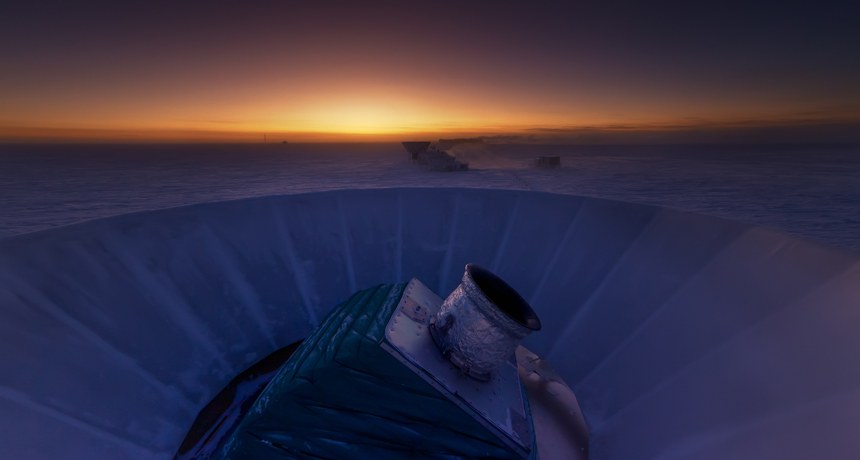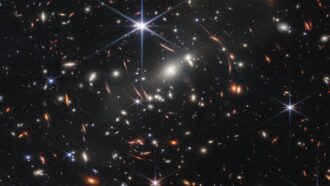Waves from the birth of time
Scientists find traces of the first growth spurt of the universe

The BICEP2 telescope, shown here at twilight, captured data from deep space that scientists say confirm one of the most important ideas about the formation of the universe.
Steffen Richter, Harvard University
On March 17, scientists reported finding the earliest echoes of the Big Bang. The long-sought evidence supports the idea that the universe inflated in a flash. A scientific theory, called inflation, held that during the first trillionth of a trillionth of a trillionth of a second after the Big Bang, the universe grew outward faster than the speed of light. It soon stretched out farther than any telescope can see.
Cosmologists are astronomers who study the early universe. They first introduced the theory of inflation more than 30 years ago. Since then, it’s become an important part of the explanation for how the universe began. Inflation helps answer some questions raised by the Big Bang. One is why the universe looks the same in every direction. Another is why it isn’t clumpier in some directions. (Inflation would have smoothed everything out. It’s just like what happens when blowing up a party balloon.)
However, scientists couldn’t be sure inflation happened. They lacked solid evidence. The new discovery provides that evidence. It identified the lingering effects of inflation on the oldest light in the universe.
“We now have a much stronger belief that we understand the early universe than we did yesterday,” Sean Carroll told Science News on the day of the news announcement. An astrophysicist at the California Institute of Technology in Pasadena, he studies the role of energy and other physical phenomena affecting stars and other objects in space. He did not work on the new study.
But dozens of other scientists did. They couldn’t travel back in time to the Big Bang; it was 13.8 billion years ago. But they also didn’t have to. According to that inflation theory, the Big Bang sent waves rippling through the stuff of space. Known as “gravitational waves,” they would alternately squeeze and stretch the fabric of space. So their passage should have left a mark on the farthest reaches of the known universe. Scientists had sought those telltale marks.
For their search, the scientists used a telescope at the South Pole. It’s called BICEP2 (short for the Background Imaging of Cosmological Extragalactic Polarization). By gauging the temperature of deep space, this telescope works almost like a giant thermometer. Scientists built it deep in Antarctica. The region’s cold, dry and stable air is perfect for peering deep into space — and back into time.
For 50 years, scientists have known that energy in the form of microwave radiation lingered long after the Big Bang. BICEP2 studies this type of light. The telescope records the behavior of photons. Those particles transport radiation, like this microwave signal.
John Kovac led the new search for the Big Bang’s echoes. An astronomer, he works at the Harvard-Smithsonian Center for Astrophysics in Cambridge, Mass. His large team has just published a series of papers online. These report finding twists and turns in the patterns of the microwave photons. Kovac’s group now concludes that gravitational waves are the only plausible explanation for that.
These scientists will to continue to go over their data. They want to make sure their results didn’t arise from a problem in the telescope or some error in their analysis. And at least eight other telescopes will continue to look for similar patterns in that early light, called the cosmic microwave background radiation.
For now, many scientists are thrilled by the news. Among them is Scott Dodelson, at the Fermi National Accelerator Laboratory in Batavia, Ill. Confirmation of gravitational waves offers new opportunities for scientists to test more ideas about the nature of the universe, the astrophysicist told Science News.
“This opens up a whole new window,” he explains — “a whole new research area.”
Power Words
astronomy The area of science that deals with celestial objects, space and the physical universe as a whole. People who work in this field are called astronomers.
astrophysics An area of astronomy that deals with understanding the physical nature of stars and other objects in space.
Big Bang The rapid expansion of dense matter that, according to current theory, marked the origin of the universe. It is supported by physics’ current understanding of the composition and structure of the universe.
cosmic microwave background radiation Remnant energy (in the form of heat) from the Big Bang and that should exist throughout the universe. It is estimated to be about 2.725 degrees above absolute zero.
cosmology The science of the origin and development of the cosmos, or universe.
photon A particle representing the smallest possible amount of light or other electromagnetic radiation.
radiation Energy, emitted by a source, that travels through space in waves or as moving subatomic particles. Examples include gamma rays, visible light, infrared energy and microwaves.







